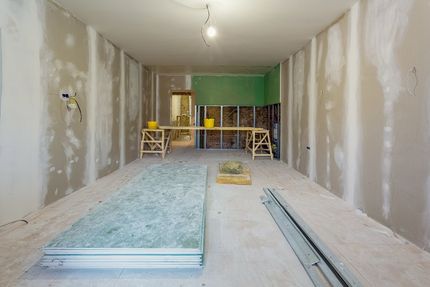Full Guide to Reliable and effective Drywall Installment
Drywall setup is a critical part of any construction or restoration project, requiring a meticulous strategy to ensure both effectiveness and dependability. Recognizing the vital tools and methods is vital, along with identifying typical mistakes that can lead to substandard results. By systematically preparing the room and executing ideal methods, one can attain a remarkable finish that stands the test of time. It is important to discover the subtleties of each action in the procedure, as they collectively add to the general success of the drywall installment. What specific techniques can boost your approach?
Necessary Tools for Drywalling
When starting a drywall installment job, having the right devices is vital for attaining a professional coating. Vital tools include a drywall blade, measuring tape, and a T-square, which are basic for accurate measurements and smooth cuts. A drywall lift is likewise very valuable, especially for ceiling setups, enabling less complicated handling of heavy panels.
For attaching the drywall, a cordless drill and drywall screws are necessary. The drill needs to be geared up with a drywall little bit to make certain effectiveness and precision. Additionally, an essential device is the drywall saw, which promotes reducing about electric outlets and other barriers.

Moreover, protective gear such as safety and security glasses and a dust mask are essential to make sure individual security during the installment process. Using the right devices not only improves the top quality of the installation but additionally enhances the operations, making the task extra efficient general.
Preparing the Space

Following, assess the problem of the ceilings and wall surfaces. Fix any existing damages, such as openings, cracks, or peeling off paint, to make sure a smooth and also surface area for drywall application. Additionally, check for electric outlets, plumbing lines, and heating and cooling air ducts, noting their areas to avoid difficulties during setup.
It is likewise crucial to determine the area properly, identifying the dimensions of the wall surfaces and ceilings to compute the proper amount of drywall required. Produce a comprehensive plan that special info consists of the design and alignment of the drywall panels.
Installment Methods
Reliable installment techniques are essential for attaining a specialist surface in drywall tasks. Correct dimension and cutting of drywall sheets are basic steps.
When hanging drywall, begin with the top and work downward, ensuring that the lengthy side of the board is vertical to the framework. Secure the sheets with screws as opposed to nails, which offer higher holding power and lower the danger of popping. Area screws every 12 inches along the sides and every 16 inches in the area of the board.
For edges, utilize edge grains to attain sharp, clean sides. When installing on ceilings, utilize a drywall lift or have a companion help in holding the sheets in position (drywall contractor). Keep a space of about 1/4 inch over the floor and ceiling to fit expansion and tightening
Ending Up Touches

Once the tape is in location, it's time to apply the first coat of joint compound, additionally recognized as mud. Make use of a 10 to 12-inch taping knife to spread out the compound uniformly over the taped joints, feathering the edges to mix with the bordering drywall.
Allow the compound to dry extensively, generally 1 day. After drying, sand the surface area gently with fine-grit sandpaper to remove any blemishes. drywall contractor. Repeat the mudding and sanding procedure, generally two to 3 coats, making certain each layer is flush and smooth with the drywall surface
Typical Blunders to Avoid
Several DIY enthusiasts experience challenges during drywall setup that can jeopardize the final outcomes. One usual error is stopping working to properly cut and gauge i was reading this drywall sheets.
An additional regular error is incorrect attachment. Making use of also couple of screws or nails can lead to loose drywall, while overdriving bolts can create the paper to tear, damaging the framework. It's vital to dig this maintain regular spacing, generally every 16 inches, and to guarantee that bolts are flush with the surface.
Moreover, not addressing wetness issues prior to installment can lead to mold and mildew growth and architectural damages. Constantly examine the setting and use moisture-resistant drywall in high-humidity locations.
Verdict
Reputable and reliable drywall setup calls for careful interest to detail throughout the process. Preventing common errors better adds to an expert result, emphasizing the importance of accuracy and technique in successful drywall projects.
It is vital to discover the subtleties of each action in the process, as they jointly contribute to the general success of the drywall installation.When embarking on a drywall setup job, having the right devices is essential for attaining a specialist surface.For attaching the drywall, a cordless drill and drywall screws are necessary.Properly preparing the room is important for a successful drywall installment.Reliable installment methods are crucial for achieving a specialist surface in drywall projects.